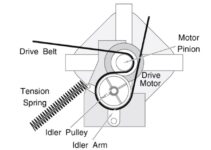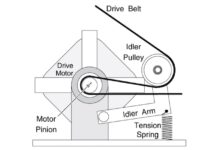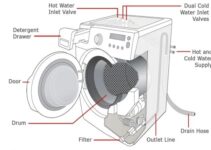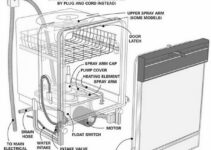Delta Kitchen faucets are among the most popular options on the faucet market. One of the reasons for their popularity is the reputation of the Delta brand.
The Delta kitchen faucet might not really differ from those offered by other brands in terms of design, however, the quality of its materials makes it a stand-out option. Rust and leaks are almost non-existent with Delta Kitchen faucet.
If you’re about to install a Delta Kitchen Faucet in your Kitchen, it is important to know the parts that make up the faucet and how each part works. This information would come in handy when installing the faucet.
This article shows a detailed diagram showing the various parts of the Delta kitchen faucet and explains how each part works.
Delta Kitchen Faucet Parts Diagram
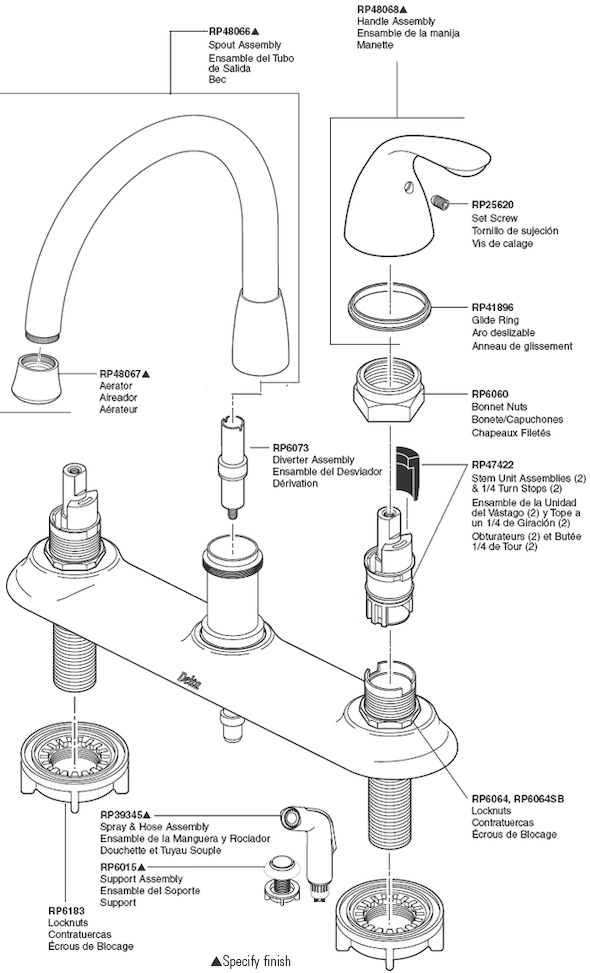
Delta Kitchen Faucet Parts Explained in Detail
Aerator
The aerator of a faucet is a small round device that is screwed inside the faucet’s tip. It is a crucial part of the faucet. The purpose of the aerator is to produce a splash-free flow of water. This makes the faucet more efficient unlike those without.
The aerator performs this by mixing air and water in a way that achieves an optimum water flow level and a smooth stream of water. With the aerator, the quality of water flow is significantly improved using the aerator. Another function is that it helps in filtering out debris that accumulates inside the faucet. You would have to check the aerator for debris regularly to maintain its performance
Spout
The spout is the part of the faucet that gets water in the right direction. This is the most recognizable part of the faucet. It ensures the delivery of water to the sink from the body of the faucet. With pull-out or pull-down faucets, the nozzle head can be extended to an extent that it faces a direction that’s opposite to the body of the faucet. This gives it more reach.
High-Arc faucet spouts are the most common type of spouts which are usually a part of pull-down faucets. Straight spouts and gooseneck spouts are other common options. Gooseneck spouts offer a more aesthetically pleasing feel, however, straight spouts offer ergonomic superiority and are usually the go-for option for pull-out faucets.
Faucet lever
The Faucet lever is the control for the water supply. The function of this component is to turn the water on and off during normal operation. Most kitchen sinks feature only a single lever that can be turned left or right to control the temperature of the water and the water flow.
Cold Water Supply
This refers to the component in the system that allows cold water to be supplied from the main water source to the faucet where it can be used.
Hot Water Supply
This refers to the component in the system that allows hot water to be supplied from the main water source to the faucet where it can be used.
Shut off valves
The function of the shut-off valves is to control the flow of water to the sink. Turning the shut-off valves off stops the flow of water.
Compression couplings
Compression couplings help to connect two different pipes to your fixture and valves. The compression couplings are located between your hot water supply line and cold water supply line. They’re also located between the left and right valves and covered by the escutcheon.
Common Materials: Brass, Stainless Steel, Plastic, Zinc
Kitchen faucets are built with several materials. The most common options include brass, plastic, stainless steel, and zinc. Brass is the most popular material for kitchen faucets. The choice is due to its durability and ease of casting. Most sprayer heads are usually made of plastic, so the overall faucet weighs less and stays cool.
Delta Kitchen Faucet Fixture Finishes
Faucet fixtures come in a range of finishes to boost their looks and complement the decor of your sink.
Chrome
Chrome is the most versatile and inexpensive finish for faucets It is also the easiest to maintain and clean. Among its many perks is its durability and ease to match with accessories and other fixtures due to its popularity. however, chrome finishes do show water spots and fingerprints quite easily.
Stainless Steel
Stainless steel is a more expensive, yet more durable option. it is tarnish-resistant, corrosion-resistant, and scratch-resistant. It is also easy to maintain though it is not as shiny as the chrome finish. However, stainless steel finish won’t show water spots or fingerprints as easily as chrome. Keep in mind that if you’re going for a stainless steel finish, you will find a variety of types among different brands,
Nickel
Nickel is another very popular option. When it comes to the Nickel finish, you can choose between a polished or brushed finish. The polished finish has an appealing shine to it. The finish is also easy to clean and highly durable. The brushed finish is more durable and won’t show fingerprints, water spots, or signs of wear. It is also a very popular finish which makes it easy to match. Maintenance won’t pose a problem as it is very easy to clean.
Bronze
Bronze finishes vary between oil-rubbed bronze and champagne bronze. The oil-rubbed bronze finish is a better choice for users aiming for a rich bathroom design. it is just as durable as a chrome or stainless steel finish. It is also easy to clean and does not show fingerprints or water spots.
Champagne bronze is a more popular and recent finish. It gained popularity due to interior designers choosing the option for its appealing industrial look. Like the other, this durable bronze finish won’t show any signs of wear, water spots or fingerprints. However, it is not the easiest to match with complimentary fixture finishes.
Matte Black
Once the most trendy bathroom finish, matte black adds an impressive depth to your bathroom faucet and makes for a better accent piece. It is also very durable and won’t show dirt or fingerprints. However, it is very difficult to pair the finish with other fixtures.
